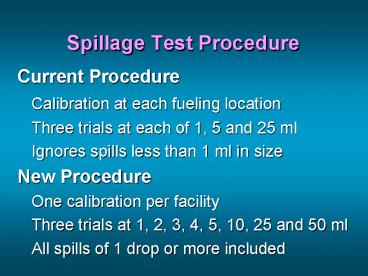Spillage Test Procedure - PowerPoint PPT Presentation
1 / 13
Title:
Spillage Test Procedure
Description:
... 25 ml. Ignores spills less than 1 ml in size. New Procedure ... Proposed Revisions to the Certification Procedure. More Stringent Standards and Specifications ... – PowerPoint PPT presentation
Number of Views:101
Avg rating:3.0/5.0
Title: Spillage Test Procedure
1
Spillage Test Procedure
- Current Procedure
- Calibration at each fueling location
- Three trials at each of 1, 5 and 25 ml
- Ignores spills less than 1 ml in size
- New Procedure
- One calibration per facility
- Three trials at 1, 2, 3, 4, 5, 10, 25 and 50 ml
- All spills of 1 drop or more included
2
Dripless Nozzles
- No more than 1 drop per fueling.
- Proposed Test Methodology
- Customer asked if fueling is to be a fill-up
- If yes, CARB staff requests to fuel vehicle
- Fueling is at high clip or, if no clip, fully
open - When nozzle shuts off, wait (timed) 5 secs.
- Remove nozzle from fillpipe
- Away from car, point nozzle downward
- Observe and record drips
3
Spillage, Liquid Retention, and Dripless
Nozzles
- Concern About the Magnitude of the Emissions from
these Sources - 14.2 Billion Gallons per Year in California
- 6.24 pounds per gallon of gasoline
- 20 drops 1 ml
- 3785 ml 1 gallon
- 1 drop/10 gal fueling 58.4 TPY in CA
4
Spillage, Liquid Retention, and Dripless
Nozzles
- Dripless Nozzles 1 drop / fueling 58.4
TPY - Liquid Retention 100 ml / 1,000 gals.
1ml / 10 gals - 1080 TPY 2.96 TPD
- Nozzle Spitting ? 1ml / nozzle / fueling
- Spillage 0.42 lbs /1,000 gals 11.9
TPD
5
Proposed Revisions to the Certification Procedure
- More Stringent Standards and Specifications
- Operational Test of at Least 180 Days
- Efficiency Test on 200 Vehicles
- Limits on Emissions from Processors (CO,
NOx and HAPS) - Limited Term Certifications
6
Performance Standards and Performance
Specifications
- Evidence of compliance with the standards and
specifications shall be provided in the
application for certification, along with the
results of tests demonstrating compliance. - The system shall demonstrate ongoing compliance
with all applicable standards and specifications
throughout certification testing. - Systems and components shall comply with all
performance standards and specifications
throughout the warranty period.
7
Performance Standards and Specifications Tables
- Table 3-1 Phase I Systems
- Table 4-1 All Phase II Systems
- Table 5-1 Additional - Balance Systems
- Table 6-1 Additional - All Assist Systems
- Table 7-1 Additional - Common Collection Unit
- Table 8-1 Additional - Destructive Processor
- Table 8-2 Additional - Non-Destructive
Processor
8
Performance Standards and Specifications Tables
- More than One Table Will Apply
- Examples
- Balance Tables 3-1, 4-1, 5-1
- Dispenser-based Systems (Gilbarco, Wayne,
etc) Tables 3-1, 4-1, 6-1 - Central Vacuum Systems
- Healy Tables 3-1, 4-1, 6-1, 7-1
- Hirt/Hasstech Tables all except 5-1, 8-2
9
All Phase I Systems
- Phase I Efficiency ? 98
- Emission Factor HC ? 0.17 /1000 gals
- Product Adaptor Rotatable 360o or equivalent
- Drop tube with
- Overfill Protection ? 0.17 CFH at 2.0 wc
- Vapor Adaptor ? 0.17 CFH at 2.0 wc
Rotatable 360o or equivalent Poppeted - Criteria for Pressure/Vacuum Vent Valves
10
All Phase II Systems
- Emission Factor HC ? 0.42 /1,000 gals
- Dripless Nozzles ? 1 drop per fueling
- Spillage ? 0.42 /1,000 gals (including
drips from spout) - Liquid Retention ? 100 ml/1,000 gals
- More Stringent Component Integrity
- Compatible with ORVR-equipped vehicles
- Compatible with Phase I systems
11
All Phase II SystemsUST Pressure
- Balance ? 0.00 H2O for Minimum of 16 hr/day
- ? 0.25 H2O Ave. of Positive Pressure
- Maximum of 1.5 H2O for 1 hour/day
- Assist Negative Pressure Maintained -0.25
H2O ? P ? -4.5 H2O - Innovative - System does not comply with an
identified Standard or Specification, but can
meet intent of the requirement in another way.
12
In-Station Diagnostics (ISD)
- Shall activate visible and audible alarms, and/or
prohibit dispensing, in response to certain
failures, and shall monitor and create a record
of performance for the last 12 months. - Parameters to be monitored
- UST Pressure
- Balance System Vapor Return Line (no blockage)
- Assist System Air to Liquid (A/L) Ratio, or
equivalent - Processor function
13
Questions?































